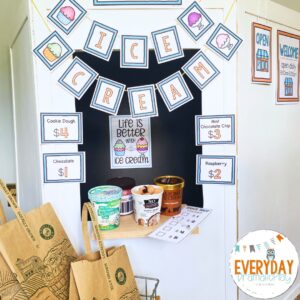Let’s use your dramatic play center to create a print rich environment for your early childhood students.
Your dramatic play center is the perfect space to provide your little learners with lots of early literacy experience that builds a strong foundation for pre-reading skills such as letter knowledge, print awareness, vocabulary, and oral language.

Creating a print rich environment for early childhood learners can be simple and fun. Follow these 5 simple steps to design the perfect print rich dramatic play center.
Download your FREE Snack Shop Dramatic Play printabale to get started today!
1. Use easy to read print friendly fonts.
Think about the age and development of your students. Many preschoolers and kindergarteners are just beginning to match and identify letters. Many fonts can be cute, fancy, and fun. However, keeping fonts simple for young learners is key.

2. Find materials or products that are familiar to your young learners.
Have your students bring in snack boxes from home, or gather snack wrappers and such from your classroom snack time. Observe and talk with your young learners about what they eat for snacks at home. Using familiar products will get your little learners excited and encourage them to engage during play time. In addition, they will feel confident when they recognize the labels and may even start to identify letters and words.


3. Add a few new or unfamiliar products.
These may be items that relate to other topics or themes you are teaching within your classroom. These products are a great way to introduce new vocabulary, knowledge of the real world, and or, perhaps, a new tasting experience for some students. When we add unfamiliar snacks to our play area, I like to give the children a chance to taste these new items.

4. Use signs and printables with simple words and images.
Pictures and images are great for beginning readers. It is also useful to have signs in your dramatic play area that are very similar and will help beginning readers make the connection between initial letters and words. For example, I like to use OPEN and CLOSED signs that are very similar (same design, same borders, same font, same image) The only difference are the words open and closed. This way my young learners need to look at the word and to decide if the Store is OPEN or CLOSED for play time. Of course, during the first few months of school we spend some of our circle time and small group time in the dramatic play area teaching letter recognition and such. Almost all of our dramatic play set up has the open/closed sign so they become very familiar with these signs. I love when students report to me that they have seen these signs in public because it demonstrates the importance of this reality-based learning.


5. Keep it simple.
When choosing products, find items that are simple for you to recreate. Think about how much time it will take you. How much money? Do you have manipulatives or materials that will work? Remember imagination is important, so things do not need to look just as they do in the real world. Let your learners be creative and expand their imaginations.
These 5 simple steps will help keep your dramatic play set up simple, playful, and effective while also creating a print rich environment that builds important early literacy skills for your early childhood learners.

Use these simple steps along with the FREE Snack Shop Dramatic Play set up or any other dramatic play printables.
What more ideas and inspirations on new ways to use the FREE Dramatic Play Snack Shop Printables?
Read these related posts.
How to Set up a Dramatic Play Snack Shop in 7 Simple Steps
Create a Dramatic Play Ice Cream Shop in 5 Simple Steps






One Response
Hi, this is a comment.
To get started with moderating, editing, and deleting comments, please visit the Comments screen in the dashboard.
Commenter avatars come from Gravatar.